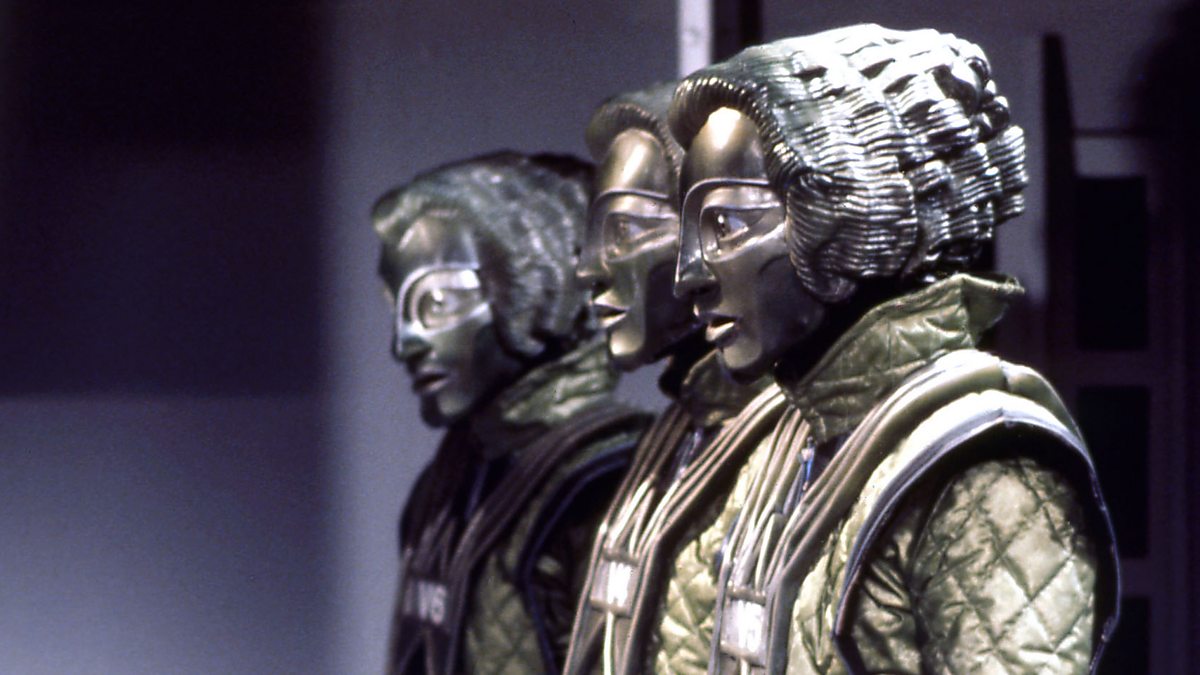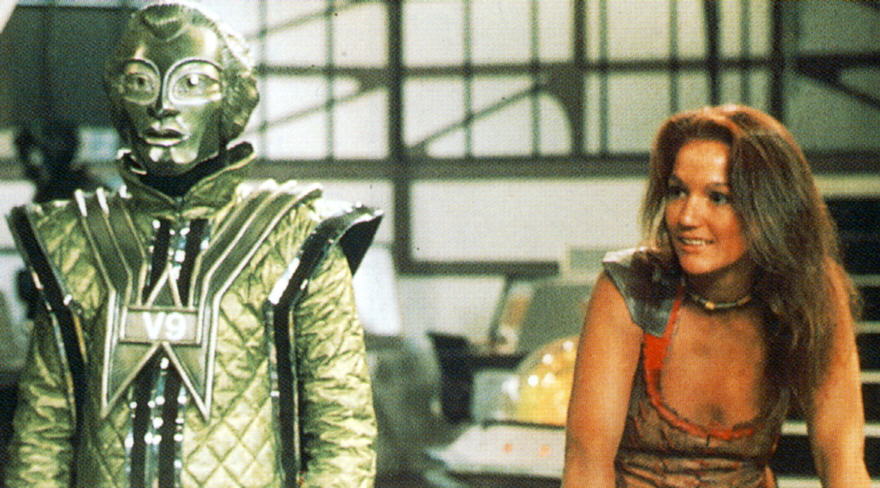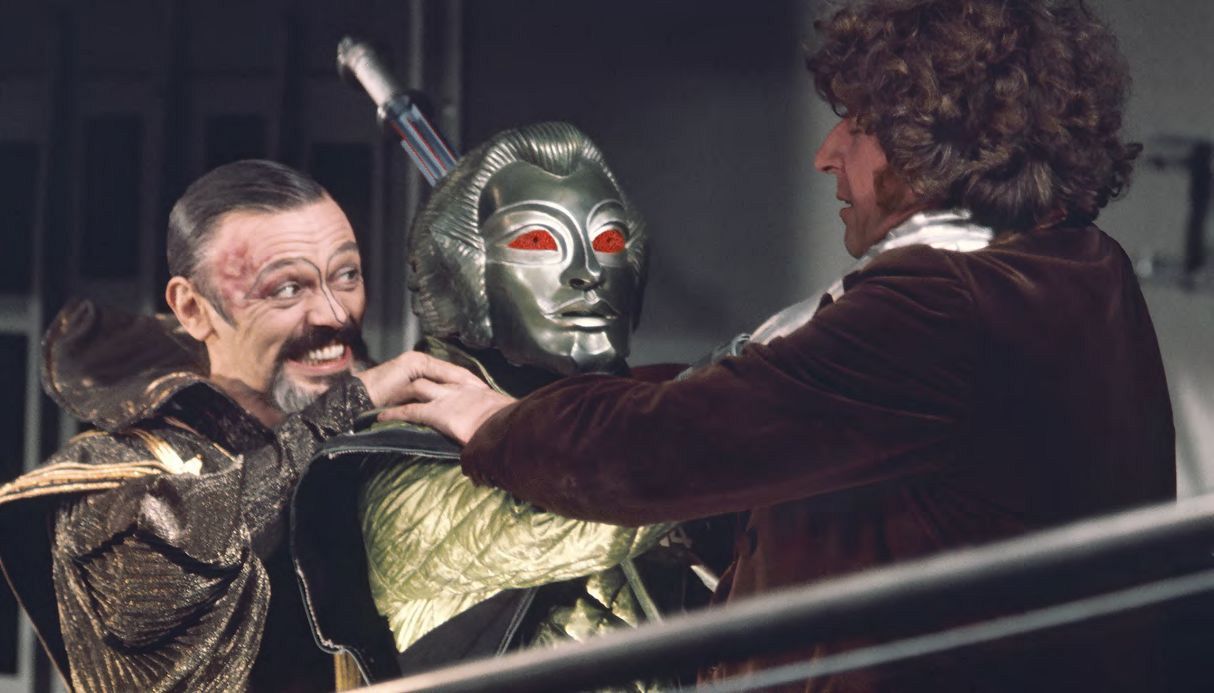DOCTOR WHO, SEASON 14 SERIAL 5:
THE ROBOTS OF DEATH
Doctor: Fourth (Tom Baker)
Companion: Leela
April 2023

IT WAS GOOD IT WAS A GOOD ONE
The Robots of Death is Leela’s second story, and it is in fact a cracking serial. It’s essentially a murder mystery/I guess slasher?, set on a mining ship on an alien planet, populated mostly with robots and only six or seven human people. And slowly, one by one, they’re being picked off... Have the robots turned on their creators? Is there any hope for this sandminer, or will infighting lead to the humans’ demise? And who is the mysterious Taren Capel?
It’s a very strong premise, though admittedly Doctor Who has fairly consistently strong premises. But this one, I’m fairly certain, pulls it off. The robots are well-realized and suitably unnerving; the sandminer is a cool setting adequately used; and frankly, I really like the whole guest cast’s costumes: they feel very odd and futuristic without looking stupid.
There’s something very interesting buried in the story’s treatment of the robot characters. They’re set up perfectly for a classic Doctor Who style reveal of sentience and subsequent revolt, leading to either a “robots are people, and people deserve respect” parable or a bungled “how dare those robots desire rights” one, both of which (unfortunately) the show has done before. But The Robots of Death wavers over both of them and ultimately lands itself in a third camp with a fair amount of success. The robots aren't people. They’re robots. They’re not sentient, not intelligent, not even creatures. They’re drones that happen to be built to resemble humans, and everything that they do in the story is because they’ve been ordered to.
Well. Almost everything. Let’s talk about D84.
This section contains spoilers:
Robots in The Robots of Death are divided into three categories. There are the D-class units, which stands for “dumb”, who can’t speak and perform basic manual labor; the V-class or Voc units, who can speak and perform more complex tasks; and the single SV unit, SV6, or “Super Voc,” who commands the Vocs. Midway through the story, it’s revealed that one of the D units—D84—can speak, and for some unknown reason has been hiding this fact. He’s a robot detective. This seems like another part of the setup for a robot revolution, but it’s revealed midway through part 4 that D84 was in fact under the command of a human—Poule. So it’s confusing when it’s not made entirely clear why D84 continues to act largely under its own command after Poule is incapacitated.
In the climax, in fact, D84 seems to make the choice to activate the anti-robot bomb, sacrificing itself to save the Doctor and the others. This is never really remarked upon, which is a shame, because it sort of undermines this whole point about the robots. But it’s also a very minor moment, and admittedly I’m sort of nitpicking here: nevertheless, though, it knocks this story down a peg. In fact, very little of this is explicitly remarked upon in the way that it sometimes is, though by and large I don’t mind.
I can’t help but compare the robots here to the modern day wave of AI becoming both more common and more (to some people) fearsome. The truth of the matter is, AI is not “intelligent” in any meaningful sense: chatbots rephrase information from Wikipedia, art bots “remix” via practical theft, ending with grotesqueries of beauty standards. But it’s not intelligent theft: it’s always just following a program. People talk about AI and algorithms “learning,” but learning is an organic process that AI is fully incapable of doing, because it’s not an actual growing sentience. AIs are machines that do what people tell them to do, replicating perfectly the biases of its creators: and I can’t help but see that in the robots hijacked by this episode’s antagonist, the mysterious and elusive Taren Capel: they do what he says. He speaks to them as though they are his friends, calling them “brother” and dressing himself up to look like them, complete with face-paint, but they never respond to him in any way other than simplistic responses to his commands. Always commands, and they always obey him, because they’re robots, and they’re programmed to. The only evil in the episode is Taren Capel himself, because the robots are not intelligent! It’s a real good core to this episode, I think.
One last thing to note is Uvanov, the foreman of the mining expedition, who is portrayed as unrepentantly money-hungry in the serial’s beginning. In fact, all of the humans on board the sandminer discuss being motivated to come on this expedition for money, but Uvanov is particularly notable because, despite being largely unsympathetic and money-minded, he ends as one of the few survivors and is in fact not responsible for even a single death—even the one he was rumored to be responsible for on a previous journey. It’s a break from Doctor Who’s norm of greedy capitalists and exploiters of nature, and it’s not bad. Just unexpected. He’s allowed to be an ass without actually being evil, which hey, there’s something to be said for that.

This is also Leela’s second story, and her first time traveling with the Doctor. And she handles herself quite well—she rescues other people, she sneaks around the ship, she stabs a robot (it doesn’t work, but), and even though she gets locked into a room once, she comes off the end of the serial feeling very much in control of herself. She also continues to have a lovely repartee with the Doctor—at the episode’s beginning, there’s a very funny exchange about a yo-yo.

Overall Thoughts:
This episode is widely considered to be very good, and with good reason. It’s a compelling murder mystery with some interesting (if subtly-defined) things to say about robotics, its characters are well-drawn, and it even looks good. No notes.
I’d rate this one above The Face of Evil, as though both are solid stories, The Robots of Death is just more well-rounded and crisply-defined, if that makes any sense. Unfortunately, next up is The Talons of Weng-Chiang, which I am dreading: the story so racist they had to put a warning up about it on Britbox. Augh. Wish me luck.
Leela Kill Tally: still 6, tragically (+0)